For most people, you will either use a smartwatch with the Wear OS by Google or Samsung's Tizen OS. What are the advantages of each smartwatch OS?
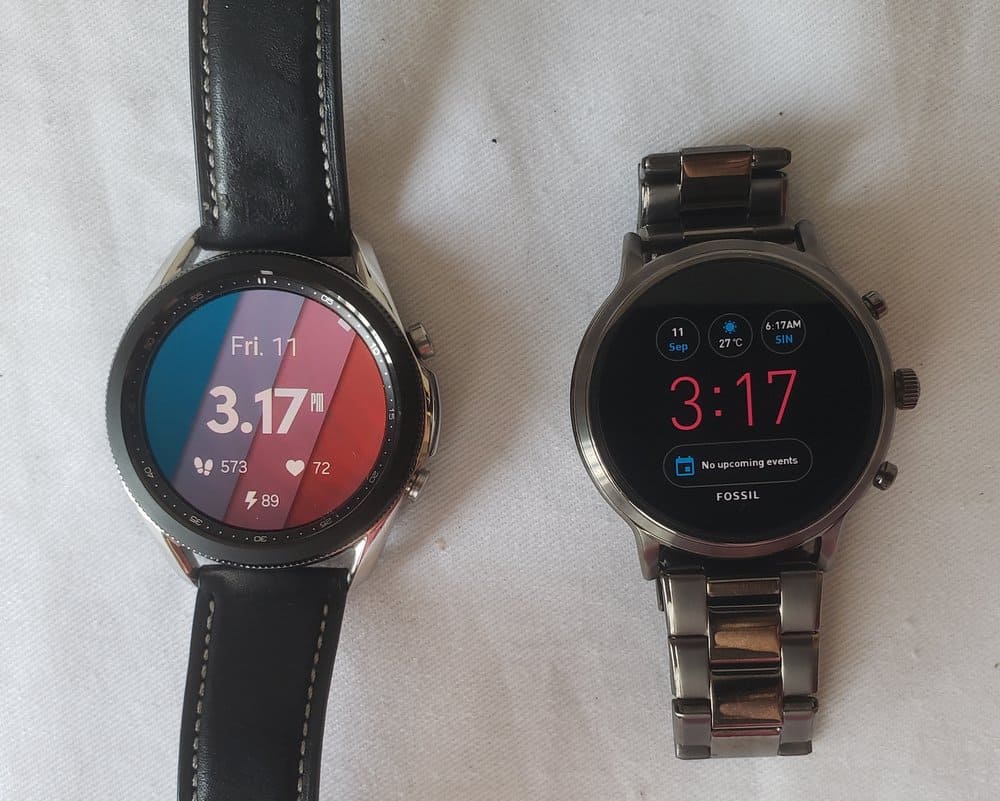
The last time I regularly wore a watch, it could only tell me the time, date and act as a stopwatch. Mine didn’t have a calculator unlike the cool kids of 1998.
Fast forward 22 years and smartwatches have made access to information so much easier and convenient. When I got my first smartwatch, I was very intrigued by how a watch could give you so much information about your workouts.
Over time, I got to appreciate the difference between the Wear OS and the Tizen OS. They are excellent systems but I have developed my own opinions of each system.
If you are an Android user and particularly if you are a Samsung smartphone user, this comparison between the Wear OS by Google and Samsung’s Tizen OS will inform you of why you should get one over another.
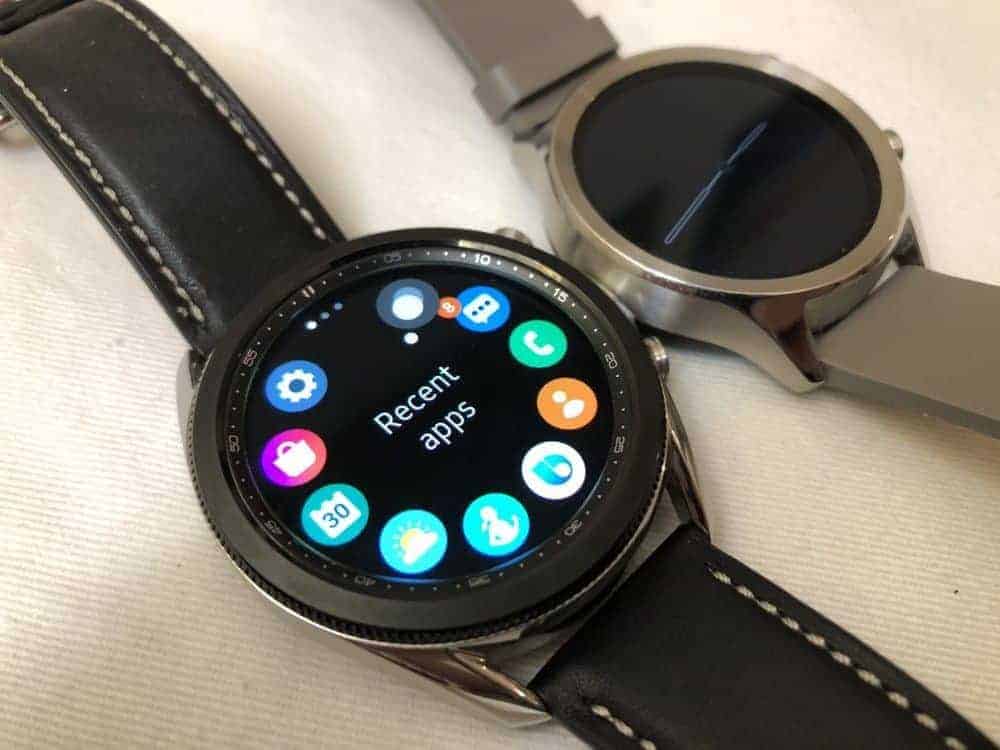
Contents
Related: Suunto 7 vs Samsung Galaxy Watch3 | Samsung Galaxy Watch3 vs Ticwatch Pro | Samsung Galaxy Watch3 vs Ticwatch C2 | Samsung Galaxy Watch3 vs Fossil Sport Smartwatch | Samsung Galaxy Watch3 vs Fossil Gen 5 Carlyle
Both are general purpose
They’re both general purpose smartwatch operating systems which means that their main focus is to bring the smart features of a smartphone closer to the user.
So, their features are, in essence, very similar and competitive with each other.
Some things you’ll find on both systems include texting, emailing, a voice assistant and workout tracking features.
There are also major points of differences such as in terms of design variety, watch face design and integration with your smartphone. Particularly, there is a much more distinct benefit of pairing a Tizen OS watch with a Samsung smartphone.
So, let’s examine the individual aspects of these two systems.
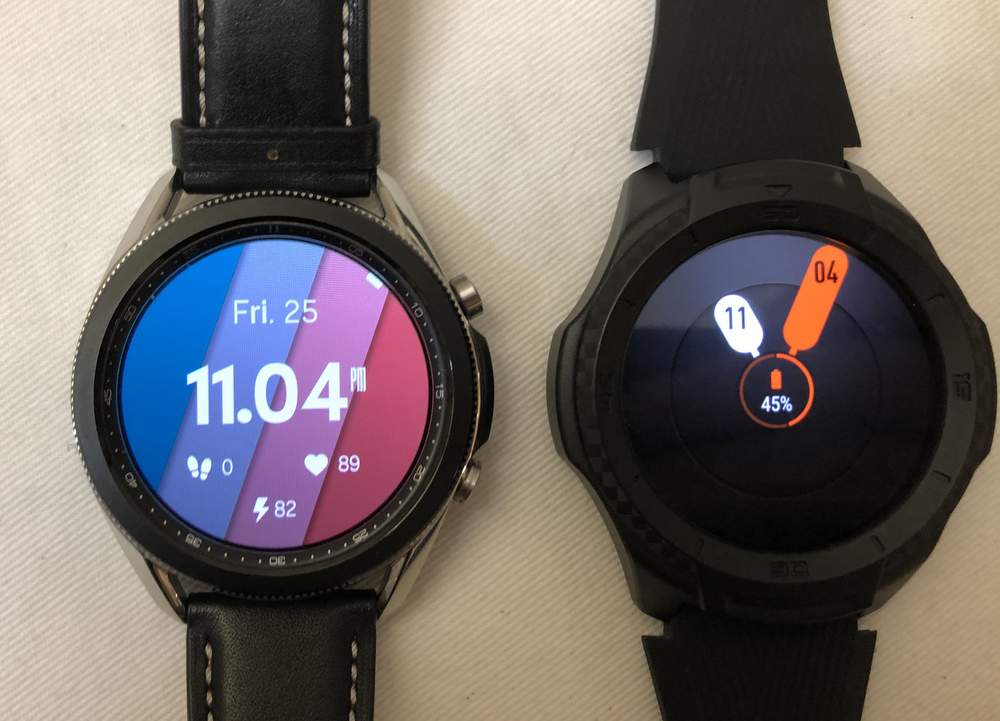
Performance
I am a bit torn on whether there’s an argument to make for this segment being part of the comparison.
Wear OS smartwatches are a bit like the gamut of Android smartphones. You can get completely underpowered rectangles with a SIM card slot, just as you can get fully-fledged computers in a sleek curved-edged smartphone.
So, some Wear OS smartwatches perform better than others. The entry level range of smartwatches from Mobvoi, who makes the Ticwatch C2,E2 and S2 and Fossil’s Sport Smartwatch can be extremely frustrating when there’s a background process which clogs up the whole system like a Los Angeles freeway at rush hour. These smartwatches have the similarity of having only a 512MB of RAM and perhaps the older Snapdragon Wear processors.
At the same time, smartwatches with higher end processors such as the newer Snapdragon Wear 4100 and more RAM, usually 1GB, can be so much smoother. A background update won’t cause the whole system to lag and struggle.
The Wear OS system has improved a lot over the time I have used it. Hardware still affects its user experience by a lot, but not as much as in the pre-pandemic times. Still, I wouldn’t take this as a sign that you should buy a cheap watch unless you are prepared to have it hang on you once in a while.
On the other hand, Samsung’s line of Tizen OS smartwatches always have decent hardware. I don’t have any complaints about its performance. Apps start quickly, menus scroll efficiently and things get done.
Winner: Tizen OS
Quality of connectivity with phone
Smartwatches need to be connected to a smartphone in order to function properly.
Not only does the Bluetooth link be reliable, but the companion smartphone app needs to be reliable too. These two conduits play an important role in reducing frustration.
A low quality bridge between the phone and the watch will cause frustration such as notifications not appearing on the smartwatch or workout data not being synced to the smartphone.
The worst offender is Fitbit, and compared to that system, the Wear OS and the Tizen OS are far, far ahead.
I have found the Tizen OS to be superior in this regard. The link is much more reliable between the devices.
Wear OS devices can sometimes leave me flustered when notifications fail to be forwarded, but generally it will be fixed if you restarted both devices and gave it time.
Winner: Tizen OS

Speech to text system
One of the most fundamental features in a general purpose smartwatch lies in its speech to text system.
If you have ever used Google Assistant, Alexa or Siri on your smartphone, you’ll know how convenient it is when the speech to text system gets it right and what happens when it misinterprets just one word from your speech.
Jargon, accents and weird syntax put these speech to text systems on the edge and these result in misinterpretations. That’s a problem that only more advanced systems can overcome.
The Wear OS has the more advanced of the two systems. The Tizen OS comes with Samsung’s speech to text system which has improved a lot, but can’t keep up with the Wear OS’s prowess.
After all, I think most people use Google to some extent. They have so much data for their machine learning systems that also give us the benefit of better transcriptions.
The Tizen OS’s transcription quality probably ranks quite low. It can’t beat the speech to text system in Fitbits, Apple Watches or Wear OS smartwatches. It might be able to compete with the Fitbit’s speech to text system, but not the heavyweights from Apple and Google.
That said, the quality of transcription has really come a long way. It’s good enough to not leave you completely flustered but still mistakes a “question mark” for “Christian mark” sometimes.
Winner: Wear OS

Voice assistant
So this leads me to the voice assistant present in both systems
The Tizen OS has Bixby while the Wear OS has Google Assistant, and I can say it right here that Google Assistant is superior.
It all comes down to dynamism and accuracy of understanding your intention. The accuracy part is partially covered by the system’s ability to transcribe speech into text, and this means that the Wear OS wins.
Here’s a scenario to drive home this point: imagine if you wanted to start a timer. Bixby will be more likely to misinterpret what you said. “Timer four minutes” has turned into “Timer for minutes” on Bixby and when that happens too much, you give up and do it the tedious way of tapping and swiping on the smartwatch.
This exact phrase mentioned above does not get misinterpreted by the Wear OS.
The other part involves understanding what you want to do. You’ll find that if you gave Google Assistant a random question, that it will search the web for an answer. Bixby will try to look for an app with a relevant ability, and if it can’t, it’ll tell you that there isn’t one.
That’s a real shame because sometimes I just want some random piece of information told to me without having to pull my smartphone out. With Bixby, I have to do it more often (ironically, to use Google Assistant on my smartphone).
Winner: Wear OS
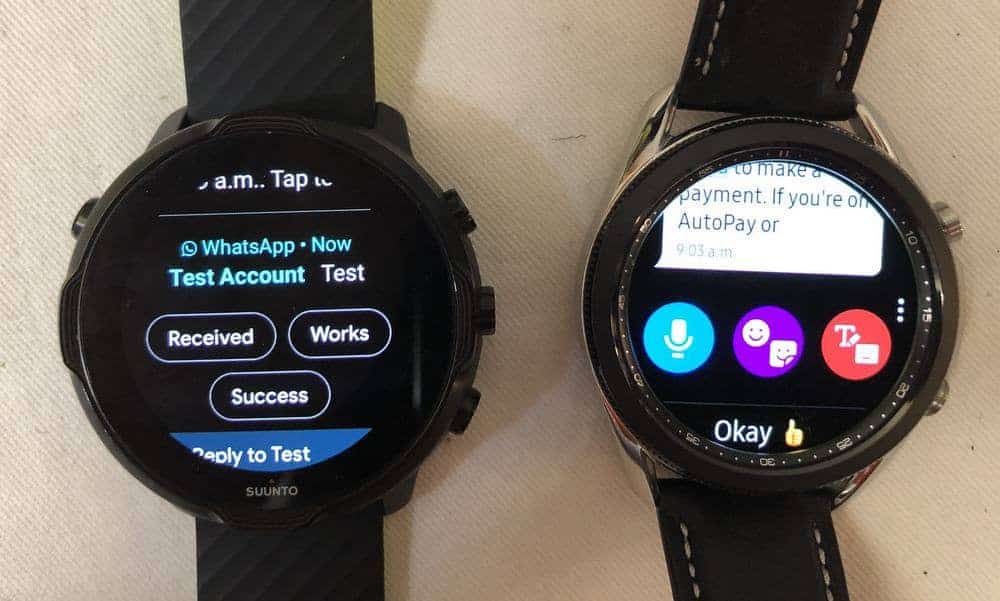
Texting, emailing and replies
When someone texts or emails you, it will appear as a notification on your smartwatch.
If you are pairing these two systems to an iPhone, note that you will only be able to read these texts and emails but you can’t reply.
You can reply to messages on both systems when paired to an Android device. You can reply using the speech to text transcription service, sending an emoji or pre-composed reply, or by using its manual inputs (e.g. on-screen keyboard or handwriting feature).
I personally only use the first two methods. I never want to touch any of the manual methods on my smartphone because it’s so tedious.
So this really gives the Wear OS an advantage because it has a good speech to text system. You are more likely to have a reliable transcription of your message with a Wear OS watch than a Tizen OS watch.
Unfortunately, the Tizen OS watch does get things wrong and sometimes that means more scrapped messages. It’ll do simple messages fine but more complicated ones usually come with an error somewhere that will convey the meaning just fine but can’t be used in a formal setting.
This happens with the Wear OS too but its reliability is much higher.
The one big advantage that Samsung has is that you can access your message and email logs from your smartwatch. This isn’t super useful, but it’s nice to have. I personally rarely use this feature because I would go directly to my phone instead.
Winner: Wear OS
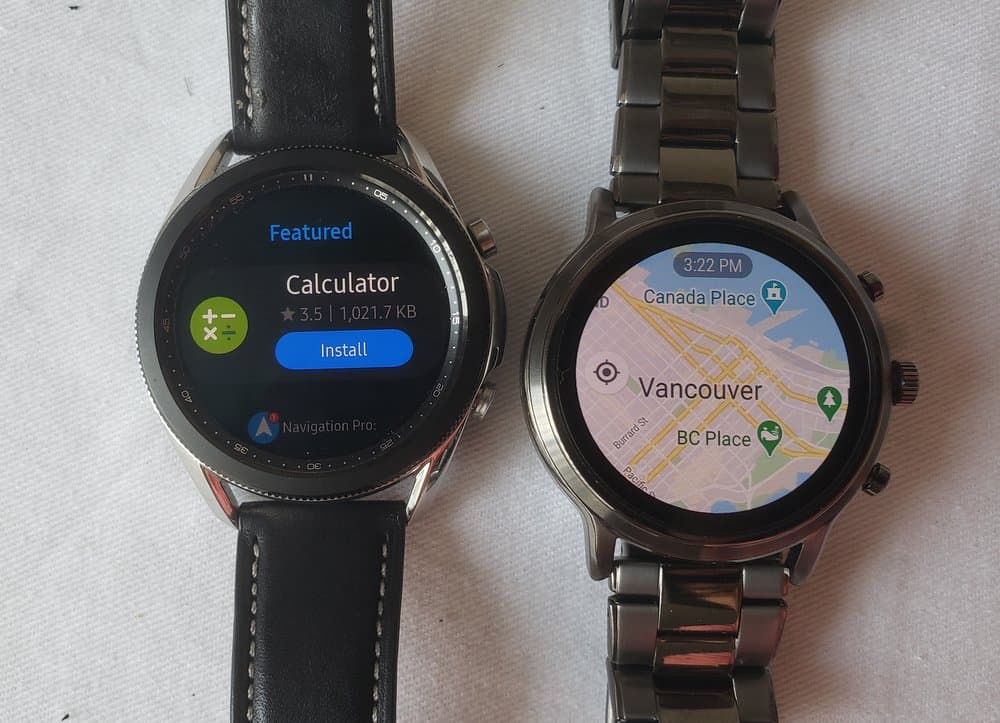
Apps
The Google Play Store is much, muuuuuuuuch bigger than the Galaxy Play Store on the Tizen OS.
The default apps on most Wear OS watches are pretty good. There’s a weather app, Google Fit, agenda and Google apps such as Google Translate.
You can also download more apps in the Google Play Store such as Google Keep and Google Maps. Google Maps is an important app because it brings a map onto your wrist, although you do need a phone nearby to supply the data connection.
The Galaxy Play Store on the Tizen OS is much more limited. I haven’t really found anything that I thought was worth downloading. Luckily, the default apps are actually very good.
Winner: Wear OS

Sports and lifestyle
The Tizen OS is really far ahead of the default Wear OS software and hardware capabilities.
No Wear OS device currently tracks sleep, nor can Wear OS devices track swimming in its default configuration.
And the default workout app on the Wear OS is Google Fit, which is great but isn’t as comprehensive as Samsung Health on Tizen OS smartwatches.
Let’s take the Samsung Galaxy Watch3 and compare it against the Fossil Gen 5 Carlyle. On the Samsung Galaxy Watch3, Samsung Health can help you track your water intake, sleep quality and blood oxygen saturation level.
These features aren’t available on the Fossil Gen 5 Carlyle, which I regard as the best Wear OS at the point of writing. Just note that the Fossil Gen 5 is also a fraction of the cost of the Galaxy Watch3.
Google Fit on the Wear OS does keep track of steps and Heart Points (which is a metric formed by the number of minutes of exercise multiplied by intensity) as well as other exercise specific metrics such as speed, distance and your location information.
Samsung Health offers a much more comprehensive analysis of your overall health than Google Fit. It keeps track of steps as well as active minutes. Tizen OS devices can also automatically track a workout if it senses you’re working out.
The biggest upside is in the running coach feature on the Galaxy Watch3. This is pretty advanced tech that’s surprisingly on a general purpose smartwatch. What the running coach does is that it analyzes your running stride and pace which can be used to improve your running.
Winner: Tizen OS

Variety
If you decide to go with the Wear OS smartwatches, you’d be in for a treat in terms of how much choice you have.
If you want offline maps, you can get the Suunto 7, which is a pretty high-spec smartwatch with the addition of the Suunto app that has advanced sports tracking features and an offline map.
If you want something that looks more formal, you can pick something from Fossil’s Gen 5 series of smartwatches. They come with different straps and watch cases to fit your preferences.
The Tizen OS only powers a handful of smartwatches, all from Samsung. They’re all premium-tier smartwatches with no entry level options. Quality control is very good and so are their designs.
That said, some Samsung smartwatches come with their really useful rotating bezel which can be used to scroll menus and texts. This is a Samsung innovation not seen elsewhere that I really like.
The Wear OS really offers much more variety in both software and hardware options but the Samsung line of smartwatches offer reliability and quality throughout their range so I am on the fence on whether there’s a winner in this case.
Winner: Tie



